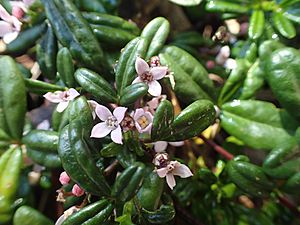Headland zieria facts for kids
Quick facts for kids Headland zieria |
|
|---|---|
 |
|
| Z. prostrata in the Australian National Botanic Gardens | |
| Conservation status | |
| Scientific classification | |
| Genus: |
Zieria
|
| Species: |
prostrata
|
The Zieria prostrata, also known as headland zieria, is a special plant from the citrus family, called Rutaceae. It only grows in the Coffs Harbour area of New South Wales, Australia. This means it is endemic to that small region.
This plant is a low-growing shrub that spreads out along the ground. Its leaves have three small parts, called leaflets. The flowers are usually pink when they are buds and turn white when they open. They have four petals. The headland zieria is only found on four specific headlands and is considered an endangered plant.
Contents
What Does Headland Zieria Look Like?
The headland zieria is a shrub that grows low to the ground or scrambles over other plants. It can reach about 0.5 to 1 meter (1.6 to 3.3 feet) tall. Its branches are smooth and have ridges.
- Leaves: The leaves are made up of three narrow, oval-shaped leaflets. The middle leaflet is about 10 to 16 millimeters (0.4 to 0.6 inches) long and 4 to 6 millimeters (0.16 to 0.24 inches) wide. The other two leaflets are a bit smaller. Both sides of the leaves are the same color and have tiny oil glands. The leaf stalk is about 3 to 4 millimeters (0.12 to 0.16 inches) long.
- Flowers: The flowers start as pink buds and become white when they open. They grow in small groups, usually with 3 to 7 flowers, but sometimes up to 32. These groups grow where the leaves meet the stem. Each flower has four tiny sepals (leaf-like parts under the petals) and four petals that are about 2 to 2.5 millimeters (0.08 to 0.1 inches) long. Like other zieria plants, it only has four stamens (the parts that produce pollen).
- Flowering Time: Headland zieria mainly flowers from late August to late September or October. After flowering, it produces fruit called a follicle. This fruit has up to four sections joined at the bottom. When the fruit is ripe, it bursts open to release its seeds.
How Was Headland Zieria Named?
The scientific name for this plant, Zieria prostrata, was first officially described in 1996. This was done by a scientist named James Andrew Armstrong.
The word prostrata comes from Latin. It means "down flat" or "laid low," which perfectly describes how this shrub grows close to the ground.
Where Does Headland Zieria Live?
This special zieria plant grows in low coastal heathland (a type of open land with small shrubs) on headlands. It is found in a single nature reserve near Coffs Harbour in New South Wales.
It's hard to count exactly how many plants there are. However, in 1998, the National Parks and Wildlife Service estimated there were about one thousand individual plants. Other headlands along the New South Wales coast have similar zieria plants. It's possible that more groups of this specific species might be found in the future.
Why Is Headland Zieria Endangered?
The Zieria prostrata is listed as "Endangered" under a special Australian law called the Environment Protection and Biodiversity Conservation Act 1999 (EPBC Act). This means it is at high risk of disappearing forever.
The biggest danger to the headland zieria is from introduced species. These are plants that are not native to Australia and have been brought in from other places. They can grow very fast and take over the areas where the headland zieria lives. Some of these harmful plants include:
- Kikuyu (Pennisetum clandestinum)
- Bitou bush (Chrysanthemoides monilifera)
- Lantana (Lantana camara)
These invasive plants compete with the headland zieria for sunlight, water, and nutrients, making it harder for the native plant to survive and thrive.
Images for kids



